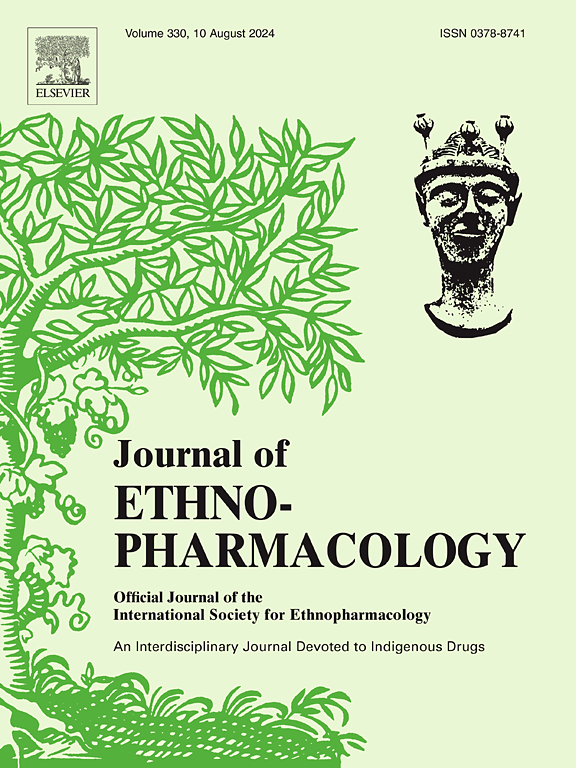Huaier enhances the antitumor effects of CDK 4/6 inhibitor by remodeling the immune microenvironment and gut microbiota in breast cancer
IF 4.8
2区 医学
Q1 CHEMISTRY, MEDICINAL
引用次数: 0
Abstract
Ethnopharmacological relevance
Trametes robiniophila Murr (Huaier), a traditional Chinese medicine (TCM), has shown promising effects as a complementary therapy in the treatment of multiple kinds of cancers.
Aim of the study
This study aimed to systematically evaluate whether Huaier could enhance the antitumor effects of palbociclib, a highly selective CDK4/6 inhibitor.
Materials and methods
A breast cancer xenograft mouse model was constructed to assess the anticancer effects of Huaier and palbociclib. Transcriptomic analysis was performed to identify the differentially expressed genes and associated pathways. Flow cytometry, immunofluorescence and immunohistochemical staining were then conducted to observe the infiltration of immune cells in the tumor microenvironment (TME). The composition of the gut microbiota was explored through 16S rDNA sequencing, and a pseudosterile mouse model was established to verify the contribution of the gut microbiota to the antitumor effects of Huaier and palbociclib.
Results
Oral administration of Huaier enhanced the antitumor effects of palbociclib in breast cancer. Transcriptomic analysis of tumor tissues revealed that the differentially expressed genes were related to immune functions. Indeed, the addition of Huaier to palbociclib therapy further increased the ratio of CD8+/CD3+ T cells and the abundance of GzmB+CD8+ T cells in the TME. Mechanistically, sequencing of 16S rDNA revealed that Huaier reshaped the gut microbiota composition in favor of Akkermansia, which positively modulated antitumor immune responses. The pseudosterile mouse model verified the necessity of the gut microbiota for the synergistic effect of Huaier on palbociclib. Furthermore, butyrate, a metabolite of Akkermansia, synergized with palbociclib to suppress tumor progression and promote the infiltration of CD8+ T cells in the TME.
Conclusions
Our data suggested that Huaier augmented the antitumor effects of palbociclib by increasing the abundance of Akkermansia in gut microbiota, which contributed to the enhancement of anti-tumor immunity. Consequently, combining palbociclib with Huaier may serve as a promising strategy for the treatment of breast cancer.

怀尔通过重塑乳腺癌的免疫微环境和肠道菌群,增强cdk4 /6抑制剂的抗肿瘤作用
中药黄鳝(槐儿)作为一种补充疗法,在多种癌症的治疗中显示出良好的效果。本研究旨在系统评价怀尔是否能增强高选择性CDK4/6抑制剂palbociclib的抗肿瘤作用。材料与方法建立乳腺癌异种移植小鼠模型,评价怀尔和帕博西尼的抗癌作用。转录组学分析鉴定差异表达基因和相关途径。流式细胞术、免疫荧光和免疫组织化学染色观察肿瘤微环境(TME)中免疫细胞的浸润情况。通过16S rDNA测序探索肠道菌群的组成,并建立假无菌小鼠模型,验证肠道菌群对怀尔和帕博西尼抗肿瘤作用的贡献。结果口服怀尔可增强帕博西尼对乳腺癌的抗肿瘤作用。肿瘤组织转录组学分析显示,差异表达基因与免疫功能有关。事实上,在帕博西尼治疗的基础上加入怀尔进一步增加了TME中CD8+/CD3+ T细胞的比例和GzmB+CD8+ T细胞的丰度。机制上,16S rDNA测序显示,怀尔重塑了肠道菌群组成,有利于Akkermansia,从而积极调节抗肿瘤免疫反应。假无菌小鼠模型验证了怀尔对帕博西尼协同作用的肠道菌群的必要性。此外,Akkermansia的代谢物丁酸盐与palbociclib协同抑制肿瘤进展并促进CD8+ T细胞在TME中的浸润。结论怀尔通过增加肠道菌群中Akkermansia的丰度来增强帕博西尼的抗肿瘤作用,从而增强抗肿瘤免疫。因此,帕博西尼与怀尔联合治疗可能是一种很有前景的乳腺癌治疗策略。
本文章由计算机程序翻译,如有差异,请以英文原文为准。
求助全文
约1分钟内获得全文
求助全文
来源期刊

Journal of ethnopharmacology
医学-全科医学与补充医学
CiteScore
10.30
自引率
5.60%
发文量
967
审稿时长
77 days
期刊介绍:
The Journal of Ethnopharmacology is dedicated to the exchange of information and understandings about people''s use of plants, fungi, animals, microorganisms and minerals and their biological and pharmacological effects based on the principles established through international conventions. Early people confronted with illness and disease, discovered a wealth of useful therapeutic agents in the plant and animal kingdoms. The empirical knowledge of these medicinal substances and their toxic potential was passed on by oral tradition and sometimes recorded in herbals and other texts on materia medica. Many valuable drugs of today (e.g., atropine, ephedrine, tubocurarine, digoxin, reserpine) came into use through the study of indigenous remedies. Chemists continue to use plant-derived drugs (e.g., morphine, taxol, physostigmine, quinidine, emetine) as prototypes in their attempts to develop more effective and less toxic medicinals.
 求助内容:
求助内容: 应助结果提醒方式:
应助结果提醒方式:


